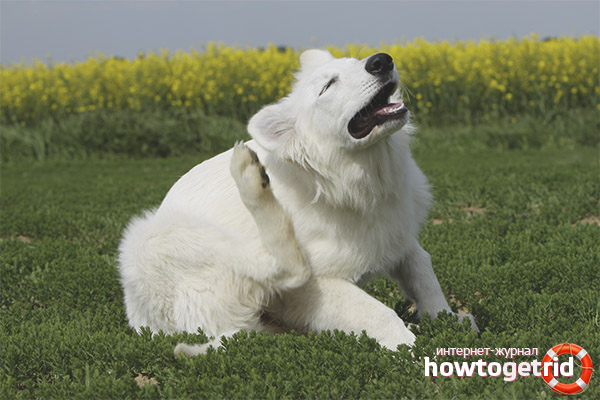The content of the article
Sometimes it happens that the owner is confident in the absence of fleas from his dog, but the animal still itches and gnaws its skin with its teeth. This behavior can be caused by a variety of reasons. In addition to fleas, other insects parasitizing on its body can irritate the skin of the dog. In addition, the cause may be illness.
Possible reasons
When the dog experiences severe itching, he combes his skin with claws and teeth. As a result, complications may arise - various bacteria can penetrate through the wounds. What are the most common causes that cause itching in a pet other than fleas? It:
- ectoparasites;
- allergy to any substance;
- skin diseases of a different nature;
- increased fat secretion by the skin;
- stressful situations;
- systemic diseases of various origins.
Since there are quite a few possible reasons, the owner, most likely, will not be able to determine the root cause on his own. To avoid unpleasant consequences - you should show the dog to the veterinarian.
Let us consider in more detail each of the possible reasons.
Ectoparasites
On pets, not only fleas, but also other common parasites can parasitize. Lice, lice-eaters or ticks settle on them. When we treat a dog from fleas, we do not get one hundred percent certainty that we completely destroyed them. Fleas remain on carpet, furniture, on dog bedding. In addition, they may not die after one treatment and in the dog’s coat. If there are no fleas, it is necessary to inspect the hair to make sure that there are no other parasites. There are many types of ticks that can irritate a dog and cause harm to it, in addition, it could pick up walk-eaters.
- Ixodid tick is dangerous because it can cause pyroplasmosis, hemobartonellosis, ehrlichiosis. Their saliva causes irritation, causing the dog to scratch its neck, ears and head. In addition, the dog may be allergic to the bites of certain parasites. As a result, a rash appears. The dog constantly itches, damaging its skin, and increasing the risk of bacteria entering the body. The diseases are quite serious, so the pet should definitely be shown to the veterinarian.
- A gamasid tick can live in small rodents or birds. But this tick can also settle on the dog.
- Subcutaneous mites are able to live for a long time first on the skin, eating dead corn particles. When the animal's immunity falls, this tick penetrates under the integument. The dog begins to itch a lot. A female tick lays eggs. As a result, inflammation and a rash develop. The dog begins to comb the places around the eyes, as well as in the mouth.
- The itch mite causes scabies. Due to the characteristic symptoms that it causes, it is also called itching. The dog can become infected with prolonged contact with a sick animal. The insect penetrates the skin within half an hour.
- An ear mite can live in the ears of more than dogs. Often he settles in cats. The parasite feeds on sulfur and sebaceous gland secretions. This tick may well first be located in any other part of the body. If the dog scratches the ears very much - it should be checked for the presence of an ear tick.
A common symptom that there are ticks on the surface of the dog’s skin is itching. In addition, each type of tick has its own symptoms. Do not self-medicate. Only the veterinarian will correctly determine the cause, as well as prescribe a set of necessary drugs to help the pet.
To prevent infection, the dog should be treated with one of the sprays, such as Bars, Defendog and others. There are also medicines in the form of drops. For example, Serko, Ralph Club. You can put on a protective collar for the animal.
Allergy
If the dog does not have fleas or other parasites, and the itching continues anyway, you might think that the pet is allergic. It is usually caused by such factors.
- Bites of insect parasites.
- Various substances inhaled by the pet.
- Substances that make up dog hygiene products.
- Components of the feed or reaction to the transition to another feed.
- Medicines or vaccinations.
In dogs and humans, the reaction manifests itself in different ways. The features of these organisms are completely different. In dogs, allergies are mainly manifested in the form of itching and various disorders on the skin. When the dog combs the site of irritation, an infection that penetrates through the wounds may be added, which further exacerbates the situation.
Flea bites can cause such a reaction because their saliva contains a protein that the dog’s body perceives as foreign. A reaction can even occur to a single bite.
According to statistics, a fairly large percentage of dogs suffer from atopic dermatitis. The reasons for its development may be such factors:
- pollen of various plants;
- feathers of birds;
- dead skin cells of the animal itself;
- fungus;
- excrement synanthropic insects.
The dog begins to itch. Most itching is felt in areas such as paws, belly, as well as the back and tail of the animal. Stains appear on the skin. They can be seen under the hair, and in shorthair dogs they are visible with the naked eye.
Food allergies are also possible. Among the substances that can cause it, there are both proteins that lead to anaphylaxis, and other components that lead to atopy. Only a veterinarian can determine the cause and prescribe treatment for the dog. In addition, he will be able to distinguish simply intolerance from a real allergy.
What foods can cause allergies? This is meat, and most often - beef or horse meat. In addition, it often happens that the dog does not tolerate milk. It is important for the pet owner to know that allergies can occur if the feed contains soy, lamb or chicken. These products are found in high quality feed. Itching in a dog develops very severe. As a result, she begins to not only scratch, but also bite itchy places. When the dog then intensively licks the damaged areas of the body, the hair begins to fall to the bottom. As a result, its color may change. The coat thins and may fall out completely. The skin is rough.
Longhair breeds suffer from allergies leading to severe dermatitis. If the dog itches, and the coat sticks together, it is most likely wet dermatitis, which will be noticeable after cutting the hair off the site.
In addition, the dog may develop an allergy to various medications, drops, and a vaccine. Symptoms develop such as with food allergies. For example, if a dog began to itch after you applied a drop of flea to it, or visited a veterinarian to get a vaccination, that could be the reason.
Dermatosis, which is also a symptom of itching, can occur due to wearing a collar soaked with insecticides. The collar comes in contact with the dog’s skin, which makes her allergic. Very often this is observed in puppies, because they have more delicate skin. The dog will scratch his neck, trying to remove the collar.
To save the pet from suffering, it is necessary to identify and eliminate the cause of such a reaction. And to relieve symptoms, veterinarians usually prescribe antihistamines.
Skin diseases
Skin diseases also often cause itching in the dog. The most common of them are various dermatoses, as well as eczema and lichen.
Dermatophytosis develops in young dogs or puppies. It can also develop after a decrease in immunity. Mycosis can lead to itching. As a result of such a lesion, the pet's hair falls out, the nails peel and turn yellow, the skin on the legs begins to peel off, and may even begin to crack. It is necessary to show the pet to a specialist.He will prescribe treatment with drugs that have an antimycotic effect. It can be shampoos, such as Dermazole or Nizoral, a special tool for dogs.
If the dog is healthy - he does not have dandruff or it is almost imperceptible. If it is formed, it means that the dog develops seborrhea, which can be caused by various factors. If decorative dogs like Spitz start to itch a lot, they have dry seborrhea. This is because the owners often bathe such "sofa" doggies. Because of this, their skin begins to dry out, the sebaceous glands do not work properly. Lack of fat leads to dandruff on the skin. If it does not appear due to a serious illness, it can be treated with anti-seborrhea shampoo.
Very often, representatives of breeds suffer from dermatitis, in which the skin forms large folds. It can be such breeds as a pug or mastiff. If the pet begins to scratch its face - check the folds. The skin in these places may turn red, become wet.
Treatment consists of treatment with agents that destroy the bacteria and then dry them. If the disease is started, the veterinarian will prescribe a course of antibiotics.
Increased function of the sebaceous glands
Sometimes a pet may develop a so-called “greasy tail”. Most often, cats suffer from such a violation, but it can also develop in dogs. This pathology develops due to hyperfunction of the sebaceous glands, which are located on the tail and at its base. As a result, the hair begins to stick together, oily seborrhea develops. Such a violation causes discomfort in the animal. The dog begins to gnaw its tail, lick it intensively. This leads to injury or alopecia.
To get rid of the problem, you must use a special shampoo that will help restore the normal functioning of the sebaceous glands in the dog. But in any case, it is necessary to show the pet to the veterinarian in order to identify the cause of such a disorder.
Stress
Dogs, like humans, are subject to various stresses. With prolonged exposure, they can affect the health of the animal. Often stresses cause various skin problems in dogs. Sometimes a reaction may appear on a short-term effect, but when it disappears, it quickly passes. It can be a cry of the owner, a visit to the veterinarian, an unpleasant smell. When a stressful situation affects a pet for a long time, it may develop seborrhea or allergies. This will lead to the fact that the dog will begin to lick or gnaw some areas of the skin.
To heal a pet, it is necessary to identify what exactly causes such a reaction. You should surround your four-legged friend with care, pay attention to him, take him for walks. To distract the dog, you can take it to games or start training. If the stress persists, the veterinarian may prescribe sedatives.
Whatever the reason for the development of itching in the pet - it is necessary to identify it as soon as possible. Only a specialist can do this correctly. After all, the owner, sorting out possible causes and making attempts to help, can lose valuable time. As a result, the problem may worsen even more.
Video: the dog itches and bites itself - what to do?












Submit